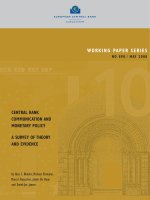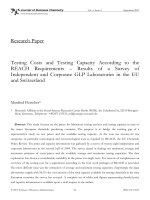A survey of fixed point and economic game theory
Bạn đang xem bản rút gọn của tài liệu. Xem và tải ngay bản đầy đủ của tài liệu tại đây (833.04 KB, 9 trang )
Asian Journal of Economics and Banking (2019), 3(2), 41–49
41
Asian Journal of Economics and Banking
ISSN 2588-1396
/>
A Survey of Fixed Point and Economic
Game Theory
Premyuda Dechboon1 , Wiyada Kumam2 , and Poom Kumam1,3 ❸
1 KMUTT-Fixed
Point Research Laboratory, KMUTT-Fixed Point Theory and Applications Research Group, Department of Mathematics, Faculty of Science, King Mongkut’s
University of Technology Thonburi (KMUTT), 126 Pracha-Uthit Road, Bang Mod,
Thrung Khru, Bangkok 10140, Thailand
2 Program in Applied Statistics, Department of Mathematics and Computer Science,
Faculty of Science and Technology, Rajamangala University of Technology Thanyaburi
(RMUTT), Thanyaburi, Pathum Thani 12110, Thailand
3 Center of Excellence in Theoretical and Computational Science (TaCS-CoE), Science
Laboratory Building, King Mongkut’s University of Technology Thonburi (KMUTT),
126 Pracha-Uthit Road, Bang Mod, Thrung Khru, Bangkok 10140, Thailand
Article Info
Abstract
Received: 16/03/2019
Accepted: 16/08/2019
Available online: In Press
This paper surveys the development of fixed point
theory regarding to game theory. Moreover, we
focus on the theoretical results applied for economics. Many recent papers are also collected
and summarized throughout a particular period
of time.
Keywords
Fixed point problem, Game theory, Economic equilibrium.
JEL classification
B23
MSC2010 classification
47H10, 91B50, 90-02
❸
Corresponding author: Poom Kumam. Email address:
42
P. Dechboon et al. /A Survey of Fixed Point and Economic Game Theory
1 INTRODUCTION
According to researches on fixed
point theory, its development has been
rapidly growing and playing an important role in modern mathematics.
As in most situation, the fixed point
problem is usually considered in various ways. This theory shows how the
pure relates with applied mathematics.
Therefore, it is used in solving other
branches of mathematics, for instance,
variation and optimization problems,
partial differential equations and probability problems. Also, many mathematicians go forwards for searching the
applications of these results in such diverse fields as biology (see [12]), chemistry (see [8]), economics (see [3]), game
theory (see [13]), etc.
Game theory is the study behaviors of players - people who is in
strategic situations - what to do under decision’s other players have effect. So, similar to a chess game, there
is a set of players, a set of strategies available to those players and a
range of payoffs of each integration
of strategies. Furthermore, it becomes
now a standard tool in economics.
Economists then use game theory to
explain, predict how people behave.
They have used it to study auctions,
bargaining, merger pricing, oligopolies
and much else. Contributions to game
theory are constructed by economists
through the different fields and interests, and economists commonly collect
results in game theory with work in
other areas. One of those, the theory of
equilibrium, has presently an extensive
practicability in such game theory. Its
importance has been proved by awarding the Nobel Prize for Economics to
K. Arrow in 1972, G. Debreu in 1983, J.
Nash, J. Harsanyi and R. Selten in 1994,
and R.J. Aumann and T.C. Schelling in
2005 for applying the theory of games
in economy.
The propose of this paper briefly
shows the collected fixed point theorems
applied in game theory. We begin with
an overall image of the evolution of fixed
point theory, after that, we emphasize
on its integration with economics. Finally, there exists a summary of research
directions in this area.
2 FIXED POINT PROBLEMS
Fixed point theorems require maps f
of a set X into itself under certain conditions which guarantee an existence theorem and a uniqueness theorem - how
there exists a fixed point for a mapping
and also it is a unique point.
Definition 2.1. Let f : X → X be a
mapping, and if there exists x ∈ X such
that f (x) = x, then x is called a fixed
point (fix-point) of f.
2.1
Topological Fixed Point
Theory
In 1912, L.E.J. Brouwer proved a
fixed point theorem which is in the history of topology with applications such
that it is principally a elementary theorem to game theory, for example, in
Nash equilibrium.
Theorem 2.2.
nonempty, convex,
Rn , and let f : X
uous function from
has a fixed point.
[4] Let X be a
compact subset of
→ X be a continX to itself. Then f
Asian Journal of Economics and Banking (2019), 3(2), 41-49
2.2
Metric Fixed Point Theory
Metric fixed point theory becomes
a famous tool of a scientific area because the fundamental result of Banach
in 1922.
Several research areas of mathematics and other sciences are attempted to
relate with applications of such results.
Theorem 2.3. [2] Let (X, d) be a complete metric space and f : X → X be a
contractive mapping, that is, there exists k ∈ [0, 1) such that d(f (x), f (y)) ≤
kd(x, y) for all x, y ∈ X. Then we have
the following:
1. The mapping f has a unique fixed
point x ∈ X;
2. For each x0 ∈ X, the sequence
{xn } defined by xn+1 = f (xn ) for
each n > 0 converges to the fixed
point x of f , that is, f (x) = x.
2.3
Discrete Fixed Point Theory
Tarski’s fixed point theorem was
stated in 1955. His result was in its
most general form. Moreover, it is extended to have many important results.
Theorem 2.4. [11] If f is a monotone function (an order-preserving function or isotone), that is, a ≤ b implies
f (a) ≤ f (b), on a nonempty complete
lattice, then the set of fixed points of f
forms a nonempty complete lattice.
3 GAME THEORY AND
ECONOMICS
Game theory is the study of logical analysis of conflict and cooperation
situations. Therefore, it is the explanation of how players would react in
43
games rationally. Every player also need
the maximum payoff as possible at the
end of the game. However, the outcome is controlled by some condition.
In the same way, the outcome output
of player’s actions does not depend on
only their own choice alone but also get
results from the other players’ actions.
Then, this is the reason that conflict and
cooperation can be happened. A game
is defined to be any situation in which
1. The number of players who may
be an individual, but it may also
be a more general entity like a
company, a nation, or even a biological species is at least two.
2. All players have their own set of
strategies which affect how the
players select the actions.
3. The outcome of the game is assigned by the strategies which
each player chosen.
4. Each possible outcome of the
game can be represented by a numerical payoffs of different players.
In game theory, its structure can be
divided to be 2 main parts. The classical games which include mixed equilibrium, rationalizability, and knowledge.
Then, the extension games consisting
of bargaining, repeated games, complexity, implementation, and sequential
equilibrium. We can now mathematically define a game.
Definition 3.1. A strategic game is
(N, Xi , i ) consisting of
1. A finite set of players N .
44
P. Dechboon et al. /A Survey of Fixed Point and Economic Game Theory
2. For each player i ∈ N , a
nonempty set of actions Xi .
3. For each player i ∈ N , a preference relation i on X = j∈N Xj .
Note that a strategic game is called
finite if Xi is finite for all i ∈ N .
3.1
A General Model
In 1950, J. Nash described the concept of the n-person game as follows.
Definition 3.2. [9] The normal form
of an n-person game is (Xi , i )ni=1 ,
where for each i ∈ {1, 2, 3, ..., n}, Xi is a
nonempty set of individual strategies of
player i and i is the preference relation
on X := i∈I Xi of player i.
Note that the individual preferences i are often represented by utility functions, that is, for each i ∈
{1, 2, 3, ..., n} there exists a real valued
function ui : X := i∈I Xi → R, such
that
x
i
An Economic Model
The situation that there are n agents
who produce and sell m goods. Assume that m is the number of production units. Let Ai ⊆ Rl be a set of plans
each agent use. In each production unit
j ∈ {1, 2, 3, ..., m}, the activity is organized according to a production plan
dj ∈ Rl . Agents are both producers and
consumers. We have
αji ≥ 0, ∀i ∈ {1, 2, ..., n}, Σni=1 αji = 1
for each j ∈ {1, 2, ..., l}
The preference relation of the consumer i on the consumption plans set
Ai is denoted by i and assume that is
represented by the utility function ui .
Definition 3.4. [1] An economy ε is
represented as
n
ε = {(Ai )ni=1 , (Dj )m
j=1 , (wi )i=1 ,
m,n
n
(∼i )i=1 , (αji )j,i=1 }.
where P represents the set of all normalized price systems.
y if and only if ui (x) ≥ ui (y)
for all x, y ∈ X. Therefore, the normal
form of n-person game can be written
as (Xi , ui )ni=1 also.
Moreover, an equilibrium of such
game is defined and it is well-known as
Nash equilibrium.
Definition 3.3. [9] The Nash equilibrium for the normal game is a point
x ∈ X which satisfies for each i ∈
{1, 2, 3, ..., n},
ui (x) ≥ ui (x−i , xi )
for each xi ∈ Xi where x−i
(x1 , x2 , ..., xi−1 , xi+1 , ..., xn ).
3.2
=
Denote by A and D the sets of complete consumption plans, respectively,
production plans, i. e., A := ni=1 Ai ,
+
D := m
= Σni=1 Ai ,
j=1 Dj and by A
D+ = Σm
j=1 Dj .
For a given price system p ∈ P ,
and a complete production plan d =
(d1 , d2 , ..., dm ) ∈ D, the budget set of
agent i is defined as
Bi (p, d) = {αi ∈ Ai : p, ai ≤ p, ωi +
Σm
j=1 αji p, dj }.
Definition 3.5. [1] A competitive
equilibrium of ε is (a∗ , d∗ , p∗ ) ∈ A ×
D × P satisfy the following conditions
Asian Journal of Economics and Banking (2019), 3(2), 41-49
45
1. For each j ∈ {1, 2, ..., m}, p∗ , d∗j ≥ the utility functions, one can define the
preference correspondences as follows
p∗ , dj for all dj ∈ Dj .
2. For each i ∈ {1, 2, ..., n}, a∗i ∈
Bi (p∗ , d∗ ) and a∗i
i ai for all
∗ ∗
ai ∈ Bi (p , d )
Pi (x) := {yi ∈ Ai (x) :
ui (x, yi ) > ui (x, xi )}.
∗
3. Σni=1 a∗i ≤ Σni=1 ωi + Σm
j=1 dj
Then the condition of maximizing
the utility function to obtain the equilibrium point becomes
∗
4. p∗ , Σni=1 a∗i −Σni=1 ωi −Σm
j=1 dj = 0.
Ai (x)∩Pi (x) = ∅ for each i ∈ {1, 2, ..., n}.
Condition 4. says that prices become 0 when the offer is higher than the
demand.
After that, some constraint correspondences have been considered.
Definition 3.6. [6] An abstract
economy Γ = (Xi , Ai , ui )ni=1 is defined
as a family of n ordered, where Ai :
n
Xi
are corresponX :=
i=1 Xi → 2
dences and ui : X × Xi → R.
G. Debreu stated the definition of
equilibrium in 1952 which it is a natural
extension of equilibrium introduced by
J. Nash.
W. Shafer and H. Sonnenschein’s
model can be described as follows:
Definition 3.8. [10] Let the set of
agents be the finite set 1, 2, ..., n. For
each i ∈ {1, 2, ..., n}, let Xi be a
nonempty set. An abstract economy
Γ = (Xi , Ai , Pi )ni=1 is defined as a family
of n ordered, where for each i ∈ I
1. Ai : X := ni=1 Xi → 2Xi is a constraint correspondence
2. Pi : X := ni=1 Xi → 2Xi is a preference correspondence.
An equilibrium for W. Shafer and H.
Sonnenschein’s model is defined as follows
Definition 3.7. [6] An equilibrium
for Γ is a point x ∈ X which satisfies
for each i ∈ {1, 2, 3, ..., n},
Definition 3.9. [10] An equilibrium
for Γ is a point x ∈ X := ni=1 Xi which
satisfies for each i ∈ {1, 2, 3, ..., n},
xi ∈ Ai (x) and ui (x) ≥ ui (x−i , xi )
xi ∈ Ai (x) and Ai (x) ∩ Pi (x) = ∅
for each xi ∈ Ai (x).
for each xi ∈ Ai (x).
In 1975, W. Shafer and H. Sonnenschein proposed a model of abstract
economy with a finite set of agents.
Each agent has a constraint correspondence Ai and, instead of the utility
function ui , they have a preference correspondence Pi . This model generalizes G. Debreu’s model, whereas, using
4 FIXED POINT THEORY VIA
GAMES
Since Kakutani’s fixed point theorem extends Brouwer’s Theorem to setvalued functions. Then, we recall a definition of a fixed point for a multivalued
mapping (or correspondence).
46
P. Dechboon et al. /A Survey of Fixed Point and Economic Game Theory
Definition 4.1. Let F(X) be the family of all closed convex subsets of X. A
point mapping x → ϕ(x) ∈ F(X) of X
into F(X) is called upper semicontinuous if
xn → x0 , yn ∈ ϕ(xn ) and yn → y0
imply y0 ∈ ϕ(x0 )
It is easy to see that this condition
is equivalent to saying that the graph of
ϕ(x) : Σx∈X x × ϕ(x) is a closed subset
of X × X.
Definition 4.2. A point x ∈ X is said
to be a fixed point of the multivalued
mapping F if x ∈ F (x).
Therefore the general fixed point
theorem can be stated as
Theorem 4.3. [14] Let X be a
nonempty, convex, compact subset of
Rn , and let F : X → 2X be an upper semicontinuous, nonempty-valued,
closed-valued, and convex-valued correspondence. Then F has a fixed point.
This leads to illustrate how fixed
point theorems adapted in game theory.
Theorem 4.4. [14] The strategic game
(N, Xi , i ) has a Nash equilibrium if Xi
is a nonempty, compact, convex subset
of a Euclidean space and i is continuous and quasi-concave on Xi for all
i ∈ N.
Fixed point theorems on such mappings constitute one of the most important arguments in the fixed point theory
of correspondences.
Definition 4.5. Let X and Y be any
sets. The graph of a correspondence
F : X ⇒ Y , denoted Gr(F ), is the set
Gr(F ) := {(x, y) ∈ X × Y : y ∈ F (x)}.
Another important kind of correspondence in fixed point theory is the
class of closed correspondences. So,
there is an important property for correspondences.
Definition 4.6. A correspondence F :
X ⇒ Y is closed if it has a closed
graph, i.e., Gr(f ) is a closed subset of
X ×Y.
Many correspondences have been
improved in reaching some new results
in game theory along with fixed point
theorems, namely, LS -majorized, Umajorized, Fθ -majorized, etc.
Definition 4.7. [7] Let X be a topological space, and Y be a nonempty subset of a vector space E, θ : X → E be
a mapping and φ : X ⇒ Y be a correspondence, then
1. φ is said to be of class Qθ (or Q)
if
a. for each x ∈ X, θ(x) ∈
/
clφ(x)
b. φ is lower semicontinous with
open and convex values in Y
2. φx is a Qθ -majorant of φ at x,
if there is an open neighborhood
N (x) of x in X and φx : N (x) ⇒
Y such that
a. for each z ∈ N (x), and
φ(z) ⊂ φx (z) and θ(z) ∈
/
clφx (z)
b. φ is lower semicontinous with
open and convex values;
Asian Journal of Economics and Banking (2019), 3(2), 41-49
3. φ is said to be Qθ -majorized if
for each x ∈ X with φ(x) = ∅,
there exists a Qθ -majorant φx of
φ at x.
Liu and Cai did not only define Qθ majorized but they also gave the result
of an existence of a maximal element in
2001.
Theorem 4.8. [7] Let X be a paracompact convex subset of a Hausdorff
locally convex topological vector space
E, D a nonempty compact metrizable
subset of X. Let P : X ⇒ D be
Qθ -majorized, then there exists a point
x ∈ X such that P (x) = ∅.
Moreover, an existence of equilibria
in abstract economy are proved as well.
47
Then Γ has an equilibrium point, i.e.,
there exists a point x∗ ∈ X such that
for each i ∈ I, x∗i clBi (x∗ ) and Ai (x∗ ) ∩
Pi (x∗ ) = ∅.
Next, it is LS -majorized correspondence and its results which is introduced
in book of KKM theory and applications in nonlinear analysis.
Definition 4.10. [15] Let Ai : X ⇒ Yi
be a correspondence for each i ∈ I.
Then Ai is said to be
1. of class LS if
a. Ai is convex valued
b. yi ∈
/ Ai (S(y)) for each y ∈ Y
c. A−1
i (yi ) := {x ∈ X : yi ∈
Ai (x)} is open in X for each
y i ∈ Yi
Theorem 4.9.
[7] Let Γ
=
(Xi , Ai , Bi , Pi )i∈I be an abstract economy where I is any (countable or uncountable) set of agents such that for
each i ∈ I
2. LS -majorized if for each x ∈ X,
there exists an open neighborhood
N (x) of x in X and a convexvalued mapping Bx : X ⇒ Yi ,
which is called an LS -majorant of
Ai at x, such that
1. Xi is a nonempty convex subset of Hausdorff locally topological vector space Ei , X := i∈I Xi
is paracompact, Di is nonempty
compact metrizable subset of Xi
a. Ai (z) ⊂ Bx (z) for each z ∈
N (x)
b. yi ∈
/ Bx (S(y)) for each y ∈ Y
−1
c. Bx (yi ) is open in X for each
y i ∈ Yi .
2. Ai , Bi , Pi are correspondences
X ⇒ Di , for each x ∈ X, Ai (x)
is nonempty, Bi is lower semicontinuous and convex closed valued,
and clBi (x) ⊂ Di
Theorem 4.11. [15] Let X be a compact Hausdorff topological space and
Y be a nonempty convex subset of a
Hausdorff topological vector space E,
S : Y → X be continuous and A : X ⇒
Y be LS -majorized. Then there exists
x ∈ X such that A(x) = ∅.
3. The set E i = {x ∈ X, Ai (x) ∩
Pi (x) = ∅} is closed in X
4. The mapping Ai ∩ Pi : X ⇒ Di is
Qθ -majorized,
There is a theorem in game theory
using LS -majorized correspondence in
2006 stated by S.Y. Chang.
48
P. Dechboon et al. /A Survey of Fixed Point and Economic Game Theory
Theorem 4.12.
[5] Let Γ =
{Xi , Ai , Bi , Pi }i∈I be an abstract economy, where I can be an infinite set of
agents, such that for each i ∈ I, the following conditions are satisfied
1. Xi is a nonempty convex subset
of a Hausdorff topological vector
space Ei and D is a compact subset of X := i∈I Xi
2. for each x ∈ X, Ai (x) is nonempty
and coAi (x) ⊂ Bi (x)
3. Fi = {x ∈ X : xi ∈ clBi (x)} is
closed in X
4. Ai : X ⇒ Xi has compactly open
lower sections
5. the correspondence Ai ∩ Pi : X ⇒
Xi is LS -majorized in Fi
6. for each finite set S ⊂ X,
there exists a compact convex set
K i∈I Ki containing S such that
for each x ∈ [K\D], there exists
i ∈ I such that (Ai ∩Pi )(x)∩Ki = ∅.
Then, there exists x∗ ∈ X such that
x∗i ∈ clBi (x∗ ) and Ai (x∗ ) ∩ Pi (x∗ ) = ∅
for each i ∈ I.
5 RESEARCH DIRECTIONS
Now, widespread results of fixed
point theorems applied in game theory
are to use correspondences in sense of
majorized constructing the existence of
an equilibrium for a generalized in game
theory. Secondly, they consider economic game and model through optimization problems. Otherwise, it is applied mathematics in computational science to reach in equilibrium problems in
games.
Acknowledgments
The authors acknowledge the financial support provided by the Center of
Excellence in Theoretical and Computational Science (TaCS-CoE), KMUTT.
References
[1] Arrow, K. J. and Debreu, G. (1954). Existence of an equilibrium for a competitive economy. Econometrica, 22:265–290.
[2] Banach, S. (1922). Sur les op´erations dans les ensembles abstraits et leur
application aux ´equations int´egrales. Fund. Math., 3:133–181.
[3] Border, K. C. (1989). Fixed point theorems with applications to economics
and game theory. Cambridge University Press, Cambridge.
¨
[4] Brouwer, L. E. J. (1912). Uber
Jordansche Mannigfaltigkeiten. Math. Ann.,
71(4):598.
[5] Chang, S.-Y. (2006). Noncompact qualitative games with application to equilibria. Nonlinear Anal., 65(3):593–600.
Asian Journal of Economics and Banking (2019), 3(2), 41-49
49
[6] Debreu, G. (1952). A social equilibrium existence theorem. Proc. Nat. Acad.
Sci. U. S. A., 38:886–893.
[7] Liu, X. G. and Cai, H. T. (2001). Maximal elements and equilibrium of abstract economy. Appl. Math. Mech., 22(10):1105–1109.
[8] McGhee, D. F., Madbouly, N. M., and Roach, G. F. (2004). Applications
of fixed point theorems to a chemical reactor problem. In Integral methods
´
in science and engineering (Saint Etienne,
2002), pages 133–138. Birkh¨auser
Boston, Boston, MA.
[9] Nash, Jr., J. F. (1950). Equilibrium points in n-person games. Proc. Nat.
Acad. Sci. U. S. A., 36:48–49.
[10] Shafer, W. and Sonnenschein, H. (1975). Equilibrium in abstract economies
without ordered preferences. J. Math. Econom., 2(3):345–348.
[11] Tarski, A. (1955). A lattice-theoretical fixpoint theorem and its applications.
Pacific J. Math., 5:285–309.
[12] Turab, A. (2017). Some Applications of Fixed Point Results in Biological
Sciences: Fixed Point Theory, Banach Contraction Principle and its Applications. LAP LAMBERT Academic Publishing.
[13] Urai, K. (2010). Fixed points and economic equilibria, volume 5 of Series on
Mathematical Economics and Game Theory. World Scientific Publishing Co.
Pte. Ltd., Hackensack, NJ.
[14] Yuan, A. (2017). Fixed point theorems and applications to game theory.
[15] Yuan, G. X.-Z. (1999). KKM theory and applications in nonlinear analysis,
volume 218 of Monographs and Textbooks in Pure and Applied Mathematics.
Marcel Dekker, Inc., New York.









